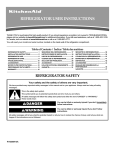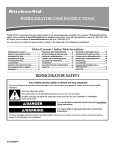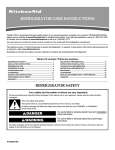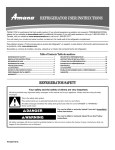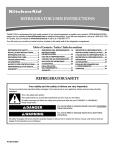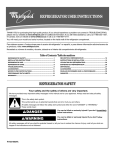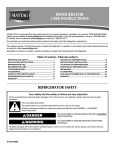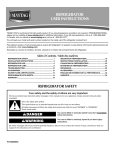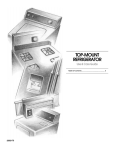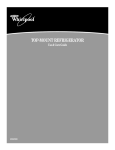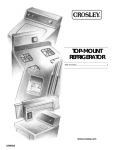Download Whirlpool 6ED2FHKXKQ Use & care guide
Transcript
® SIDE BY SIDE REFRIGERATOR Use & Care Guide Table of Contents.................2 (SPANISH) (SPANISH) (Spanish) (Spanish).................# (CHINESE) (Chinese) (Chinese).................# (KOREAN) (Korean) (Korean).................# W10139583A TABLE OF CONTENTS REFRIGERATOR SAFETY........................................................................... 2 INSTALLATION INSTRUCTIONS ............................................................... 3 Unpack the Refrigerator ........................................................................... 3 Proper Disposal of Your Old Refrigerator................................................. 3 Location Requirements............................................................................. 4 Electrical Requirements ............................................................................ 4 Refrigerator Doors .................................................................................... 5 Adjust the Doors ....................................................................................... 7 Water Supply Requirements..................................................................... 7 Connect Water Supply.............................................................................. 7 REFRIGERATOR USE ................................................................................. 8 Using the Controls .................................................................................... 8 Convertible Drawer Temperature Control ................................................ 9 Crisper Humidity Control .......................................................................... 9 Chilled Door Bin........................................................................................ 9 Water and Ice Dispensers ........................................................................ 9 Ice Maker and Storage Bin..................................................................... 10 Water Filtration System .......................................................................... 11 REFRIGERATOR CARE ............................................................................ 11 Cleaning .................................................................................................. 11 Changing the Light Bulbs ....................................................................... 12 TROUBLESHOOTING ............................................................................... 12 Refrigerator Operation............................................................................ 12 Temperature and Moisture ..................................................................... 13 Ice and Water.......................................................................................... 13 ACCESSORIES .......................................................................................... 14 ASSISTANCE OR SERVICE...................................................................... 14 REFRIGERATOR SAFETY Your safety and the safety of others are very important. We have provided many important safety messages in this manual and on your appliance. Always read and obey all safety messages. This is the safety alert symbol. This symbol alerts you to potential hazards that can kill or hurt you and others. All safety messages will follow the safety alert symbol and either the word “DANGER” or “WARNING.” These words mean: DANGER WARNING You can be killed or seriously injured if you don't immediately follow instructions. You can be killed or seriously injured if you don't follow instructions. All safety messages will tell you what the potential hazard is, tell you how to reduce the chance of injury, and tell you what can happen if the instructions are not followed. IMPORTANT SAFETY INSTRUCTIONS WARNING: To reduce the risk of fire, electric shock, or injury when using your refrigerator, follow these basic precautions: ■ Plug into a grounded (earthed) outlet. ■ Do not remove ground prong. ■ Do not use an adapter. ■ ■ Do not use an extension cord. ■ Disconnect power before servicing. ■ Replace all parts and panels before operating. ■ Remove doors from your old refrigerator. ■ Use nonflammable cleaner. ■ Keep flammable materials and vapors, such as gasoline, away from refrigerator. ■ Use two or more people to move and install refrigerator. ■ Disconnect power before installing ice maker (on ice maker kit ready models only). ■ ■ ■ ■ A qualified service technician must install the water line and ice maker. Use a sturdy glass when dispensing ice (on some models). This appliance is not intended for use by persons (including children) with reduced physical, sensory or mental capabilities, or lack of experience and knowledge, unless they have been given supervision or instruction concerning use of the appliance by a person responsible for their safety. Children should be supervised to ensure that they do not play with the appliance. If the power supply cord is damaged, it must be replaced by the manufacturer or its service agent or a similarly qualified person in order to avoid a hazard. SAVE THESE INSTRUCTIONS 2 Proper Disposal of Your Old Refrigerator WARNING Before You Throw Away Your Old Refrigerator or Freezer: ■ Take off the doors. ■ Leave the shelves in place so that children may not easily climb inside. Suffocation Hazard Remove doors from your old refrigerator. Failure to do so can result in death or brain damage. IMPORTANT: Child entrapment and suffocation are not problems of the past. Junked or abandoned refrigerators are still dangerous – even if they will sit for “just a few days.” If you are getting rid of your old refrigerator, please follow these instructions to help prevent accidents. INSTALLATION INSTRUCTIONS Unpack the Refrigerator WARNING Excessive Weight Hazard Use two or more people to move and install refrigerator. Failure to do so can result in back or other injury. Remove the Packaging ■ Remove tape and glue from your refrigerator before using. To remove any remaining tape or glue, rub the area briskly with your thumb. Tape or glue residue can also be easily removed by rubbing a small amount of liquid dish soap over the adhesive with your fingers. Wipe with warm water and dry. ■ Do not use sharp instruments, rubbing alcohol, flammable fluids, or abrasive cleaners to remove tape or glue. These products can damage the surface of your refrigerator. For more information, see “Refrigerator Safety” section. ■ On some models, shelves, bins, door shelf rails, and other feature parts may be packaged in the Interior FeaturePak. Follow the instructions contained in the package for proper assembly. When Moving Your Refrigerator: Your refrigerator is heavy. When moving the refrigerator for cleaning or service, be sure to protect the floor. Always pull the refrigerator straight out when moving it. Do not wiggle or “walk” the refrigerator when trying to move it, as floor damage could occur. Clean Before Using After you remove all of the package materials, clean the inside of your refrigerator before using it. See the cleaning instructions in “Refrigerator Care.” Important information to know about glass shelves and covers: Do not clean glass shelves or covers with warm water when they are cold. Shelves and covers may break if exposed to sudden temperature changes or impact, such as bumping. For your protection, tempered glass is designed to shatter into many small, pebble-size pieces. This is normal. Glass shelves and covers are heavy. Use special care when removing them to avoid impact from dropping. 3 Location Requirements Electrical Requirements WARNING WARNING Explosion Hazard Keep flammable materials and vapors, such as gasoline, away from refrigerator. Failure to do so can result in death, explosion, or fire. To ensure proper ventilation for your refrigerator, allow for ¹⁄₂" (1.25 cm) space on each side and at the top. When installing your refrigerator next to a fixed wall, leave 2" (5.08 cm) minimum on each side (depending on your model) to allow for the door to swing open. If your refrigerator has an ice maker, allow extra space at the back for the water line connections. Electrical Shock Hazard Plug into a grounded (earthed) outlet. Do not remove ground prong. Do not use an adapter. Do not use an extension cord. Failure to follow these instructions can result in death, fire, or electrical shock. Before you move your refrigerator into its final location, it is important to make sure you have the proper electrical connection: Recommended Grounding Method A 115 Volt 60 Hz. (Plug 1), 220/240 Volt 50 Hz. (Plugs 2 or 3), or 220 Volt 60 Hz. (Plug 3) AC only 10-amp fused and grounded (earthed) electrical supply is required. 12 / " (1.25 cm) Plug 1 2" (5.08 cm) NOTES: ■ It is recommended that you do not install the refrigerator near an oven, radiator, or other heat source. Do not install in a location where the temperature will fall below 55°F (13°C). ■ 4 Normal minimum cabinet cut-out width required for product installation is 36" (91.44 cm). However, if the product is placed against an extended wall and the ability to remove the crisper pans is desired, an additional 18" (45.72 cm) of cabinet width is required, so a total cabinet opening width of 54" (137.16 cm) is recommended. Plug 2 Plug 3 Plug 4 It is recommended that a separate circuit serving only your refrigerator be provided. Use an outlet that cannot be turned off by a switch or pull chain. Do not use an extension cord. NOTE: Before performing any type of installation, cleaning, or removing a light bulb, turn the control, (Thermostat, Refrigerator or Freezer Control depending on the model) to OFF and then disconnect the refrigerator from the electrical source. When you are finished, reconnect the refrigerator to the electrical source and reset the control (Thermostat, Refrigerator or Freezer Control depending on the model) to the desired setting. For Australia and New Zealand: Your new appliance has been especially manufactured to meet all Australian Standards and Conditions. Some notations in the installation instructions may refer to electrical requirements in other countries, so we draw your particular attention to these specific notes. Your appliance needs to be plugged into a 230/240 Volt 50 Hz. 10-amp (Plug 4) AC only earthed outlet. Refrigerator Doors Gather the required tools and parts and read all instructions before starting installation. TOOLS NEEDED: ¹⁄₄", ¹⁄₂", and ⁵⁄₁₆" hex-head socket wrenches. IMPORTANT: Before you begin, turn the refrigerator control OFF. Unplug refrigerator or disconnect power. Remove food, the ice storage bin, and any adjustable door or utility bins from doors. NOTE: To get your product through the doorway of your home, measure the doorway to see if you need to remove the whole doors. See the instructions below to remove the whole doors. WARNING Electrical Shock Hazard Disconnect power before removing doors. Failure to do so can result in death or electrical shock. 4 5 Top Left Hinge Top Right Hinge A A A A Do Not Remove Screw A 3 Do Not Remove Screw A Wiring Connection 6 Bottom Hinge A A B A. Wiring plugs B. Wiring clip Do Not Cut Wiring Clip B 2 Do Not Remove Screw A (present on some models) 7 Door Alignment Water Dispenser Tubing Connection A A. Leveling Screw A 1 Base Grille A A. Face of fitting 5 IMPORTANT: Do not remove screw A, present on some models. Remove the Doors Models without Water and Ice Dispensers WARNING Electrical Shock Hazard Disconnect power before removing doors. Failure to do so can result in death or electrical shock. Models with Water and Ice Dispensers 1. Unplug refrigerator or disconnect power. 2. Open both refrigerator doors. Remove the base grille by pulling up on the bottom outside corners. See Graphic 1. 3. Disconnect the water dispenser tubing located behind the base grille on the freezer door side. See Graphic 2. ■ Press blue outer ring against the face of fitting and pull the dispenser tubing free. NOTE: Keep the water tubing connector attached to the tube that runs underneath the freezer. The door can not be removed if the connector is still attached to the tube that runs through the door hinge. 4. Disconnect the wiring located behind the base grille on the freezer door side. See Graphic 3. ■ Unscrew the wiring clip using a ¹⁄₄" hex-head socket wrench. ■ IMPORTANT: Do not cut the clip or remove it from the wires. Disconnect wiring plugs. 5. Close both doors and keep them closed until you are ready to lift them free from the cabinet. 6. Loosen screws and remove the bottom left hinge. See Graphic 6. IMPORTANT: Do not remove screw A, present on some models. NOTE: Apply pressure against the freezer door to keep it from sliding or falling. Do not depend on the door magnets to hold the doors in place while you are working. Assistance may be needed. IMPORTANT: To aid in door alignment and closing, there is a shim located between the hinge and the cabinet. When the hinge is removed, the shim may fall out of place. If this occurs, set the shim aside so it can be put back in place when the hinge is reconnected later. 7. Lower the freezer door down out of the top hinge and remove. The water dispenser tubing and wiring remain attached to the freezer door. Be sure to protect the bottom hinge, dispenser tubing and the wiring from damage. 8. Use a ⁵⁄₁₆" hex-head socket wrench to remove the top right hinge screw and cover as shown. See Graphic 5. 9. Remove remaining top right hinge screws and hinge as shown. See Graphic 5. IMPORTANT: Do not remove screw A. 10. Lift the refrigerator door straight up off bottom hinge. 11. It may not be necessary to remove the top left hinge or bottom right hinge to move the refrigerator through a doorway. ■ If necessary, disassemble the hinges as shown. See Graphics 4 and 6. 6 1. Unplug refrigerator or disconnect power. 2. Use a ⁵⁄₁₆" hex-head socket wrench to remove the top left hinge screw and cover as shown. See Graphic 4. 3. Remove remaining top left hinge screws and hinge as shown. See Graphic 4. IMPORTANT: Do not remove screw A. 4. Lift the freezer door straight up off bottom hinge. 5. Use a ⁵⁄₁₆" hex-head socket wrench to remove the top right hinge screw and cover as shown. See Graphic 5. 6. Remove remaining top right hinge screws and hinge as shown. See Graphic 5. IMPORTANT: Do not remove screw A. 7. Lift the refrigerator door straight up off bottom hinge. 8. It may not be necessary to remove the bottom hinges to move the refrigerator through a doorway. ■ If necessary, disassemble the bottom hinges as shown. See Graphic 6. IMPORTANT: Do not remove screw A, present on some models. Replace the Doors and Hinges Models with Water and Ice Dispensers 1. Replace top left hinge and bottom right hinge, if removed. Tighten screws. 2. Reconnect the freezer door to the top left hinge. Hold in place. NOTE: Apply pressure against the freezer door to keep it from sliding or falling. Do not depend on the door magnets to hold the doors in place while you are working. Assistance may be needed. 3. Feed the water dispenser tubing and wiring through the bottom left hinge before replacing the hinge. 4. Replace the bottom left hinge, making sure the shim is between the hinge and cabinet. Tighten screws. 5. Reconnect water dispenser tubing. ■ Push tubing into fitting until it stops and the black mark touches the face of fitting. See Graphic 2. 6. Reconnect wiring plugs and wiring clip. See Graphic 3. 7. Replace the refrigerator door by lifting the door onto the bottom right hinge. 8. Align and replace the top right hinge as shown. See Graphic 5. Tighten screws. 9. Replace hinge cover and screws. Tighten screws. 10. Plug into a grounded 3 prong outlet or reconnect power. Models without Water and Ice Dispensers 1. Replace the bottom hinges, if removed. Be sure the shim is between the hinge and cabinet on each side. Tighten screws. 2. Replace the freezer door by lifting the door onto the bottom left hinge. 3. Align and replace the top left hinge as shown. See Graphic 4. Tighten screws. 4. Replace hinge cover and screws. Tighten screws. 5. Replace the refrigerator door by lifting the door onto the bottom right hinge. 6. Align and replace the top right hinge as shown. See Graphic 5. Tighten screws. 7. Replace hinge cover and screws. Tighten screws. 8. Plug into a grounded 3 prong outlet or reconnect power. ■ Adjust the Doors Your refrigerator has two front adjustable rollers — one on the right and one on the left. If your refrigerator seems unsteady or if you want the doors to close more easily, adjust the refrigerator's tilt using the instructions below: 1. Move the refrigerator into its final location. 2. The two leveling screws are part of the front roller assemblies which are at the base of the refrigerator on either side. See Graphic 7. 3. Use a ¹⁄₂" hex-head wrench to adjust the leveling screws. Turn the leveling screw to the right to raise that side of the refrigerator or turn the leveling screw to the left to lower that side. It may take several turns of the leveling screws to adjust the tilt of the refrigerator. See Graphic 7. NOTE: Having someone push against the top of the refrigerator takes some weight off the leveling screws and rollers. This makes it easier to adjust the screws. 4. Open both doors again and check to make sure that they close as easily as you like. If not, tilt the refrigerator slightly more to the rear by turning both leveling screws to the right. It may take several more turns, and you should turn both leveling screws the same amount. 5. Replace the base grille. NOTE: Be sure to refasten the Tech Sheet behind the base grille. Water Supply Requirements Gather the required tools and parts before starting installation. Read and follow the instructions provided with any tools listed here. TOOLS NEEDED: ■ Flat-blade screwdriver ■ ¹⁄₄" Nut driver ■ ⁷⁄₁₆" and ¹⁄₂" Open-end or two adjustable wrenches ■ ¹⁄₄" Drill bit ■ Cordless drill NOTE: Your refrigerator dealer has a kit available with a ¹⁄₄" (6.35 mm) saddle-type shutoff valve, a union, and copper tubing. Before purchasing, make sure a saddle-type valve complies with your local plumbing codes. Do not use a piercing-type or ³⁄₁₆" (4.76 mm) saddle valve which reduces water flow and clogs more easily. IMPORTANT: ■ All installations must meet local plumbing code requirements. ■ Use copper tubing and check for leaks. Install copper tubing only in areas where the household temperatures will remain above freezing. Water Pressure A cold water supply with water pressure of between 30 and 120 psi (207 and 827 kPa) is required to operate the water dispenser and ice maker. If you have questions about your water pressure, call a licensed, qualified plumber. Reverse Osmosis Water Supply IMPORTANT: The pressure of the water supply coming out of a reverse osmosis system going to the water inlet valve of the refrigerator needs to be between 30 and 120 psi (207 and 827 kPa). If a reverse osmosis water filtration system is connected to your cold water supply, the water pressure to the reverse osmosis system needs to be a minimum of 40 to 60 psi (276 to 414 kPa). If the water pressure to the reverse osmosis system is less than 40 to 60 psi (276 to 414 kPa): ■ Check to see whether the sediment filter in the reverse osmosis system is blocked. Replace the filter if necessary. ■ If your refrigerator has a water filter, it may further reduce the water pressure when used in conjunction with a reverse osmosis system. Remove the water filter. See “Water Filtration System.” If you have questions about your water pressure, call a licensed, qualified plumber. Connect Water Supply Read all directions before you begin. IMPORTANT: If you turn the refrigerator on before the water line is connected, turn the ice maker OFF. Connect to Water Line Style 1 1. Unplug refrigerator or disconnect power. 2. Turn OFF main water supply. Turn ON nearest faucet long enough to clear line of water. 3. Locate a ¹⁄₂" (12.70 mm) to 1¹⁄₄" (3.18 cm) vertical cold water pipe near the refrigerator. IMPORTANT: ■ Make sure it is a cold water pipe. ■ Horizontal pipe will work, but drill on the top side of the pipe, not the bottom. This will help keep water away from the drill and normal sediment from collecting in the valve. 4. Determine the length of copper tubing you need. Measure from the connection on the lower rear corner of refrigerator to the water pipe. Add 7 ft (2.1 m) to allow for cleaning. Use ¹⁄₄" (6.35 mm) O.D. (outside diameter) copper tubing. Be sure both ends of copper tubing are cut square. 5. Using a cordless drill, drill a ¹⁄₄" (6.35 mm) hole in the cold water pipe you have selected. A B G C F A. Cold water pipe B. Pipe clamp C. Copper tubing D. Compression nut E D E. Compression sleeve F. Shutoff valve G. Packing nut 6. Fasten the shutoff valve to the cold water pipe with the pipe clamp. Be sure the outlet end is solidly in the ¹⁄₄" (6.35 mm) drilled hole in the water pipe and that the washer is under the pipe clamp. Tighten the packing nut. Tighten the pipe clamp screws slowly and evenly so the washer makes a watertight seal. Do not overtighten or you may crush the copper tubing. 7. Slip the compression sleeve and compression nut on the copper tubing as shown. Insert the end of the tubing into the outlet end squarely as far as it will go. Screw the compression nut onto outlet end with adjustable wrench. Do not overtighten. 8. Place the free end of the tubing in a container or sink, and turn ON the main water supply. Flush the tubing until water is clear. Turn OFF the shutoff valve on the water pipe. Coil the copper tubing. Style 2 1. Contact your dealer or a Whirlpool-designated service company for proper installation. 2. Unplug refrigerator or disconnect power. 3. Connect the supplied hose to a potable water supply. Allow the storage tank on the reverse osmosis system to refill after heavy usage. 7 NOTE: Tighten the nut by hand. Then tighten it with a wrench two more turns. Do not overtighten. Connect to Refrigerator Style 1 1. Unplug refrigerator or disconnect power. 2. Attach the copper tube to the valve inlet using a compression nut and sleeve as shown. Tighten the compression nut. Do not overtighten. 3. Use the tube clamp on the back of the refrigerator to secure the tubing to the refrigerator as shown. This will help avoid damage to the tubing when the refrigerator is pushed back against the wall. 4. Turn shutoff valve ON. 5. Check for leaks. Tighten any connections (including connections at the valve) or nuts that leak. A B A. Bulb B. Nut (provided) A 4. Turn shutoff valve ON. 5. Check for leaks. Tighten any nuts or connections (including connections at the valve) that leak. B Style 4 C D A. Tube clamp B. Copper tubing C. Compression nut D. Valve inlet 1. Unplug refrigerator or disconnect power. 2. Connect the supplied hose to the water valve outlet on the back of the refrigerator. Complete the Installation 6. The ice maker is equipped with a built-in water strainer. If your water conditions require a second water strainer, install it in the ¹⁄₄" (6.35 mm) water line at either tube connection. Obtain a water strainer from your nearest appliance dealer. WARNING Style 2 1. Unplug refrigerator or disconnect power. 2. Remove and discard the black nylon plug from the gray water tube on the rear of the refrigerator. 3. If the gray water tube supplied with the refrigerator is not long enough, a ¹⁄₄" x ¹⁄₄" (6.35 mm x 6.35 mm) coupling is needed in order to connect the water tubing to an existing household water line. Thread the provided nut onto the coupling on the end of the copper tubing. NOTE: Tighten the nut by hand. Then tighten it with a wrench two more turns. Do not overtighten. Electrical Shock Hazard Plug into a grounded 3 prong outlet. Do not remove ground prong. Do not use an adapter. Do not use an extension cord. Failure to follow these instructions can result in death, fire, or electrical shock. A B C A. Refrigerator water tubing B. Nut (provided) C. Bulb D. Coupling (purchased) D E F G E. Ferrule (purchased) F. Nut (purchased) G. Household water line 1. Plug into a grounded 3 prong outlet. 2. Flush the water system. See “Prepare the Water System” or “Water and Ice Dispensers.” NOTE: Allow 24 hours to produce the first batch of ice. Allow 3 days to completely fill ice container. REFRIGERATOR USE 4. Turn shutoff valve ON. 5. Check for leaks. Tighten any nuts or connections (including connections at the valve) that leak. Style 3 1. Unplug refrigerator or disconnect power. 2. Remove and discard the black nylon plug from the gray water tube on the rear of the refrigerator. 3. Thread the provided nut onto the water valve as shown. Using the Controls For your convenience, your refrigerator controls are preset at the factory. When you first install your refrigerator, make sure that the controls are still preset. The Refrigerator Control and the Freezer Control should both be set to the “mid-settings.” Freezer cold 8 1 2 3 Refrigerator 4 colder off 1 2 3 4 colder IMPORTANT: ■ Your product will not cool when the REFRIGERATOR Control is set to OFF. ■ The Refrigerator Control adjusts the refrigerator compartment temperature. The Freezer Control adjusts the freezer compartment temperature. ■ Settings to the left of the mid-setting make the temperature less cold. Settings to the right of the mid-setting make the temperature colder. ■ Wait 24 hours before you put food into the refrigerator. If you add food before the refrigerator has cooled completely, your food may spoil. NOTE: Adjusting the Refrigerator and Freezer Controls to a higher (colder) than recommended setting will not cool the compartments any faster. To store meat: Set the control to one of the three MEAT settings to store meat at its optimal storage temperature. To store vegetables: Set the control to VEG to store vegetables at their optimal storage temperatures. NOTE: If food starts to freeze, move the control to the left (less cold). Remember to wait 24 hours between adjustments. Crisper Humidity Control (on some models) You can control the amount of humidity in the moisture-sealed crisper. Adjust the control to any setting between LOW and HIGH. LOW (open) for best storage of fruits and vegetables with skins. HIGH (closed) for best storage of fresh, leafy vegetables. Adjusting Controls NOTE: Give the refrigerator time to cool down completely before adding food. It is best to wait 24 hours before you put food into the refrigerator. The settings indicated in the previous section should be correct for normal household refrigerator usage. The controls are set correctly when milk or juice is as cold as you like and when ice cream is firm. ■ Slide the control one setting to the right to make the compartment colder. ■ Chilled Door Bin (on some models) Cool air from the freezer is directed to the refrigerator door bin directly beneath the vents. NOTE: The dairy compartment and can rack are not associated with the Chilled Door Bin feature. Chilled Door Bin Control Slide the control one setting to the left to make it less cold. If you need to adjust temperatures in the refrigerator or freezer, use the settings listed in the chart below as a guide. Wait at least 24 hours between adjustments. CONDITION/REASON: ADJUSTMENT: REFRIGERATOR too warm REFRIGERATOR Control one setting higher FREEZER too warm/ too little ice FREEZER Control one setting higher REFRIGERATOR too cold REFRIGERATOR Control one setting lower FREEZER too cold FREEZER Control one setting lower The chilled door bin control is located on the left-hand side of the refrigerator compartment. A A. Chilled door bin control Disabling Sounds ■ To turn off all dispenser and control sounds, press and hold ICE and FILTER at the same time for 3 seconds. ■ To turn all sounds back on, press and hold ICE and FILTER at the same time for 3 seconds again. NOTE: On some models, the display screen on the dispenser control panel has a backlight, which will turn off automatically when the control buttons have not been used for 30 seconds or more. When the backlight is off, the first press of a control button will only reactivate the backlight, without changing any settings. Within 30 seconds after the backlight has been reactivated, additional presses of control buttons will change the applicable settings. ■ Slide the door chill control to the left to reduce the flow of cold air to the bin and make it less cold. ■ Slide the door chill control to the right to increase the flow of cold air to the bin and make it colder. Water and Ice Dispensers (on some models) Depending on your model, you may have one or more of the following options: the ability to select either crushed or cubed ice, a special light that turns on when you use the dispenser, or a lock option to avoid unintentional dispensing. NOTES: ■ The dispensing system will not operate when the freezer door is open. ■ After connecting the refrigerator to a water source, flush the water system. Use a sturdy container to depress and hold the water dispenser lever for 5 seconds, then release it for 5 seconds. Repeat until water begins to flow. Once water begins to flow, continue depressing and releasing the dispenser lever (5 seconds on, 5 seconds off) for an additional 2 minutes. This will flush air from the filter and water dispensing system. Additional flushing may be required in some households. As air is cleared from the system, water may spurt out of the dispenser. ■ Allow 24 hours for the refrigerator to cool down and chill water. Convertible Drawer Temperature Control The control can be adjusted to properly chill meats or vegetables. The air inside the pan is cooled to avoid “spot” freezing and can be set to keep meats at the National Livestock and Meat Board recommended storage temperatures of 28° to 32°F (-2° to 0°C). The convertible vegetable/meat drawer control comes preset at the lowest meat setting. 9 Allow 24 hours to produce the first batch of ice. Discard the first three batches of ice produced. ■ The display screen on the dispenser control panel has a backlight, which will turn off automatically when the control buttons have not been used for 30 seconds or more. When the backlight is off, the first press of a control button will only reactivate the backlight, without changing any settings. Within 30 seconds after the backlight has been reactivated, additional presses of control buttons will change the applicable settings. ■ The Water Dispenser IMPORTANT: Dispense enough water every week to maintain a fresh supply. To Dispense Water: 1. Press a sturdy glass against the water dispenser lever. 2. Remove the glass to stop dispensing. IMPORTANT: Limit water dispensing time to a maximum of 2 minutes at a time. The Ice Dispenser Ice dispenses from the ice maker storage bin in the freezer when the dispenser lever is pressed. The dispensing system will not operate when the freezer door is open. To turn off the ice maker, see “Ice Maker and Storage Bin.” Your ice maker can produce both crushed and cubed ice. Before dispensing ice, select which type of ice you prefer by pressing the ICE button. The display screen indicates which type of ice is selected. The Dispenser Light (on some models) When you use the dispenser, the light will automatically turn on. If you want the light to be on continuously, you may choose either ON or DIM. The display screen indicates which mode is selected. ON DIM ON: Press LIGHT to turn the dispenser light on. DIM: Press LIGHT a second time to select DIM mode. The dispenser light will remain on, but at a lower intensity. OFF: Press LIGHT a third time to turn the dispenser light off. The dispenser lights are LEDs that can not be changed. If it appears that your dispenser lights are not working, see “Troubleshooting” for more information. The Dispenser Lock (on some models) The dispenser can be turned off for easy cleaning or to avoid unintentional dispensing by small children and pets. NOTE: The lock feature does not shut off power to the refrigerator, to the ice maker, or to the dispenser light. It simply deactivates the dispenser controls and levers. To turn off the ice maker, see “Ice Maker and Storage Bin.” ■ Press and hold LOCK for 3 seconds to lock the dispenser. ■ Press and hold LOCK a second time to unlock the dispenser. The display screen indicates when the dispenser is locked. LOCKED CRUSHED OFF UNLOCKED CUBED For crushed ice, cubes are crushed before being dispensed. This may cause a slight delay when dispensing crushed ice. Noise from the ice crusher is normal, and pieces of ice may vary in size. When changing from crushed to cubed, a few ounces of crushed ice will be dispensed along with the first cubes. To Dispense Ice: 1. Press the button to select the desired type of ice. WARNING Ice Maker and Storage Bin (on some models) Turning the Ice Maker On/Off Style 1 To turn ON the ice maker, simply lower the wire shutoff arm. To manually turn off the ice maker, lift the wire shutoff arm to the OFF (arm up) position and listen for the click. NOTE: Your ice maker has an automatic shutoff. As ice is made, the ice cubes will fill the ice storage bin, and the ice cubes will raise the wire shutoff arm to the OFF (arm up) position. Do not force the wire shutoff arm up or down. Style 2 Cut Hazard The On/Off switch is located on the top right-hand side of the freezer compartment. Use a sturdy glass when dispensing ice. Failure to do so can result in cuts. 2. Press a sturdy glass against the ice dispenser lever. Hold the glass close to the dispenser opening so ice does not fall outside of the glass. IMPORTANT: You do not need to apply a lot of pressure to the lever in order to activate the ice dispenser. Pressing hard will not make the ice dispense faster or in greater quantities. 3. Remove the glass to stop dispensing. NOTE: Ice may continue to dispense for up to 10 seconds after removing the glass from the lever. The dispenser may continue to make noise for a few seconds after dispensing. IMPORTANT: Limit water dispensing time to a maximum of 2 minutes at a time. 10 To turn on the ice maker, slide the control to the ON (left) position. To manually turn off the ice maker, slide the control to the OFF (right) position. NOTE: Your ice maker has an automatic shutoff. The ice maker sensors will automatically stop ice production, but the control will remain in the ON (left) position. REMEMBER: ■ Allow 24 hours to produce the first batch of ice. Discard the first three batches of ice produced. ■ The quality of your ice will be only as good as the quality of the water supplied to your ice maker. Avoid connecting the ice maker to a softened water supply. Water softener chemicals (such as salt) can damage parts of the ice maker and lead to poor quality ice. If a softened water supply cannot be avoided, make sure the water softener is operating properly and is well maintained. ■ Do not use anything sharp to break up the ice in the storage bin. This can cause damage to the ice container and the dispenser mechanism. ■ Do not store anything on top of or in the ice maker or storage bin. Removing and Replacing Ice Storage Bin Style 1 1. Pull the covering panel up from the bottom and then slide it back toward the rear. 2. Lift the wire shutoff arm so it clicks into the OFF (up) position. Ice can still be dispensed, but no more can be made. 3. Lift up the front of the storage bin and pull it out. Water Filter Status Light (on some models) The water filter status light will help you know when to change your water filter. When the water filter status display changes from “GOOD” to “ORDER,” this tells you that it is almost time to change the water filter cartridge. Replace the water filter cartridge when the water filter status display changes to “REPLACE.” If water flow to your water dispenser or ice maker decreases noticeably, change the filter sooner. The filter should be replaced at least every 6 months depending on your water quality and usage. After changing the water filter, reset the status light by pressing and holding the FILTER button for 3 seconds. The status light will change from “REPLACE” to “GOOD” when the system is reset. Changing the Water Filter 1. Press the eject button to release the filter from the base grille. 2. Pull the filter straight out. 3. Turn the cap counterclockwise to remove it from the filter. IMPORTANT: Do not discard the cap. It is part of your refrigerator. Keep the cap to use with the replacement filter. 4. Align the ridge on the cap with the arrow on the new filter and turn the cap until it snaps into place. NOTE: You can run the dispenser without a filter. Your water will not be filtered. Simply insert the cap all of the way into the base grille and rotate the cap until it is firmly in place. 5. Remove the covers from the O-rings. Be sure the O-rings are still in place after the covers are removed. 6. Push the filter into the base grille. The eject button will pop back out when the filter is fully engaged. 7. Flush the water system. See “Water and Ice Dispensers.” 4. Replace the bin by pushing it in all the way or the dispenser will not work. Push the wire shutoff arm down to the ON position to restart ice production. Make sure the door is closed tightly. Style 2 1. Hold the base of the storage bin with both hands and press the release button to lift the storage bin up and out. NOTE: It is not necessary to turn the ice maker control to the OFF (right) position when removing the storage bin. The sensor cover (“flipper door”) on the left wall of the freezer stops the ice maker from producing ice if the door is open or the storage bin is removed. REFRIGERATOR CARE Cleaning WARNING 2. Replace the storage bin on the door and push down to make sure it is securely in place. Explosion Hazard Use nonflammable cleaner. Failure to do so can result in death, explosion, or fire. Water Filtration System Do not use with water that is microbiologically unsafe or of unknown quality without adequate disinfection before or after the system. Systems certified for cyst reduction may be used on disinfected waters that may contain filterable cysts. Both the refrigerator and freezer sections defrost automatically. However, clean both sections about once a month to avoid buildup of odors. Wipe up spills immediately. IMPORTANT: Because air circulates between both sections, any odors formed in one section will transfer to the other. You must thoroughly clean both sections to eliminate odors. To avoid odor transfer and drying out of food, wrap or cover foods tightly. To Clean Your Refrigerator: NOTE: Do not use abrasive or harsh cleaners such as window sprays, scouring cleansers, flammable fluids, cleaning waxes, concentrated detergents, bleaches or cleansers containing petroleum products on plastic parts, interior and door liners or gaskets. Do not use paper towels, scouring pads, or other harsh cleaning tools. 1. Unplug refrigerator or disconnect power. 11 2. Hand wash, rinse, and dry removable parts and interior surfaces thoroughly. Use a clean sponge or soft cloth and a mild detergent in warm water. 3. Wash stainless steel and painted metal exteriors with a clean sponge or soft cloth and a mild detergent in warm water. 4. There is no need for routine condenser cleaning in normal home operating environments. If the environment is particularly greasy or dusty, or there is significant pet traffic in the home, the condenser should be cleaned every 2 to 3 months to ensure maximum efficiency. If you need to clean the condenser: ■ Remove the base grille. ■ Use a vacuum cleaner with a soft brush to clean the grille, the open areas behind the grille and the front surface area of the condenser. ■ Replace the base grille when finished. Changing the Light Bulbs NOTE: Not all bulbs will fit your refrigerator. Be sure to replace the bulb with one of the same size, shape and wattage. Replacement bulbs are available from your dealer. ■ The dispenser lights are LEDs that can not be changed. ■ All other lights require a 40-watt bulb. 1. Unplug refrigerator or disconnect power. 2. Remove light shield when applicable. NOTE: To clean the light shield, wash it with warm water and liquid detergent. Rinse and dry the shield well. 3. Remove light bulb and replace with one of the same size, shape and wattage. 4. Replace light shield when applicable. 5. Plug in refrigerator or reconnect power. 5. Plug in refrigerator or reconnect power. TROUBLESHOOTING Try the solutions suggested here first in order to avoid the cost of an unnecessary service call. Refrigerator Operation The refrigerator will not operate WARNING The motor seems to run too much Your new refrigerator may run longer than your old one due to its high-efficiency compressor and fans. The refrigerator may run even longer if the room is warm, a large food load is added, doors are opened often, or if the doors have been left open. The refrigerator is noisy Electrical Shock Hazard Plug into a grounded 3 prong outlet. Do not remove ground prong. Refrigerator noise has been reduced over the years. Due to this reduction, you may hear intermittent noises from your new refrigerator that you did not notice from your old model. Below are listed some normal sounds with an explanation. ■ Buzzing - heard when the water valve opens to fill the ice maker ■ Pulsating - fans/compressor adjusting to optimize performance ■ Rattling - flow of refrigerant, water line, or from items placed on top of the refrigerator ■ Sizzling/Gurgling - water dripping on the heater during defrost cycle ■ Popping - contraction/expansion of inside walls, especially during initial cool-down Do not use an adapter. Do not use an extension cord. Failure to follow these instructions can result in death, fire, or electrical shock. ■ Power cord unplugged? Plug into a grounded 3 prong outlet. ■ Is outlet working? Plug in a lamp to see if the outlet is working. ■ Water running - may be heard when water melts during the defrost cycle and runs into the drain pan ■ Household fuse blown or circuit breaker tripped? Replace the fuse or reset the circuit breaker. If the problem continues, call an electrician. ■ Creaking/Cracking - occurs as ice is being ejected from the ice maker mold. ■ Are controls on? Make sure the refrigerator controls are on. See “Using the Controls.” ■ New installation? Allow 24 hours following installation for the refrigerator to cool completely. NOTE: Adjusting the temperature controls to coldest setting will not cool either compartment more quickly. 12 The doors will not close completely ■ Door blocked open? Move food packages away from door. ■ Bin or shelf in the way? Push bin or shelf back in the correct position. The doors are difficult to open Ice and Water The ice maker is not producing ice or not enough ice WARNING ■ Refrigerator connected to a water supply and the supply shutoff valve turned on? Connect refrigerator to water supply and turn water shutoff valve fully open. ■ Kink in the water source line? A kink in the line can reduce water flow. Straighten the water source line. ■ Ice maker turned on? Make sure wire shutoff arm or switch (depending on model) is in the ON position. ■ New installation? Wait 24 hours after ice maker installation for ice production to begin. Wait 72 hours for full ice production. ■ Large amount of ice recently removed? Allow 24 hours for ice maker to produce more ice. ■ Ice cube jammed in the ice maker ejector arm? Remove ice from the ejector arm with a plastic utensil. ■ Reverse osmosis water filtration system connected to your cold water supply? This can decrease water pressure. See “Water Supply Requirements” in either the Installation Instruction booklet or the Use and Care Guide. Explosion Hazard Use nonflammable cleaner. Failure to do so can result in death, explosion, or fire. ■ Are the gaskets dirty or sticky? Clean gaskets with mild soap and warm water. The lights do not work ■ Is a light bulb loose in the socket or burned out? See “Changing the Light Bulbs.” ■ Is the dispenser light set to OFF? The dispenser light will operate only when the levers are pressed. If you want the dispenser light to stay on continuously, set the dispenser light to ON, or NIGHT LIGHT or AUTO or HALF or DIM. See “Water and Ice Dispensers.” ■ Is the dispenser light set to NIGHT LIGHT or AUTO? If the dispenser is set to the NIGHT LIGHT or AUTO mode, be sure the dispenser light sensor is not blocked. See “Water and Ice Dispensers.” The ice cubes are hollow or small NOTE: This is an indication of low water pressure. ■ Water shutoff valve not fully open? Turn the water shutoff valve fully open. ■ Kink in the water source line? A kink in the line can reduce water flow. Straighten the water source line. ■ Reverse osmosis water filtration system connected to your cold water supply? This can decrease water pressure. See “Water Supply Requirements.” ■ Questions remain regarding water pressure? Call a licensed, qualified plumber. Temperature and Moisture Temperature is too warm ■ New installation? Allow 24 hours following installation for the refrigerator to cool completely. ■ Door(s) opened often or left open? Allows warm air to enter refrigerator. Minimize door openings and keep doors fully closed. ■ Large load of food added? Allow several hours for refrigerator to return to normal temperature. ■ Controls set correctly for the surrounding conditions? Adjust the controls a setting colder. Check temperature in 24 hours. See “Using the Controls.” There is interior moisture buildup Off-taste, odor or gray color in the ice ■ New plumbing connections? New plumbing connections can cause discolored or off-flavored ice. ■ Ice stored too long? Discard ice. Wash ice bin. Allow 24 hours for ice maker to make new ice. ■ Odor transfer from food? Use airtight, moisture proof packaging to store food. ■ Are there minerals (such as sulfur) in the water? A water filter may need to be installed to remove the minerals. ■ Is there a water filter installed on the refrigerator? Gray or dark discoloration in ice indicates that the water filtration system needs additional flushing. NOTE: Some moisture buildup is normal. ■ Humid room? Contributes to moisture buildup. ■ Door(s) opened often or left open? Allows humid air to enter refrigerator. Minimize door openings and keep doors fully closed. The ice dispenser will not operate properly ■ Freezer door closed completely? Close the door firmly. If it does not close completely, see “The doors will not close completely.” ■ Ice bin installed correctly? Be sure the ice bin is firmly in position. ■ New installation? Wait 24 hours after ice maker installation for ice production to begin. Wait 72 hours for full ice production. ■ Ice stuck in the delivery chute? Use a plastic utensil to clear the delivery chute. ■ Has the wrong ice been added to the bin? Use only cubes produced by the current ice maker. 13 ■ Has the ice melted around the auger (metal spiral) in the ice bin? Empty the ice container. Use warm water to melt the ice if necessary. WARNING ■ Water not been recently dispensed? The first glass of water may not be cool. Discard the first glass of water. ■ Refrigerator connected to a cold water pipe? Make sure the refrigerator is connected to a cold water pipe. See “Water Supply Requirements.” ACCESSORIES To order accessories, contact your authorized Whirlpool dealer and ask for the appropriate part number listed below. Stainless Steel Cleaner and Polish: Cut Hazard Part #4396095 Use a sturdy glass when dispensing ice. Replacement Filters: Failure to do so can result in cuts. ■ Is the ice dispenser stalling while dispensing “crushed” ice? Change the ice button from “crushed” to “cubed.” If cubed ice dispenses correctly, depress the button for “crushed” ice and begin dispensing again. ■ Has the dispenser arm been held in too long? Ice will stop dispensing when the arm is held in too long. Wait 3 minutes for dispenser motor to reset before using again. Do not use with water that is microbiologically unsafe or of unknown quality without adequate disinfection before or after the system. Systems certified for cyst reduction may be used on disinfected waters that may contain filterable cysts. Standard Base Grille Water Filter Cartridge: Part #4396841 (T2RFWG2 and P2RFWG2) The water dispenser will not operate properly ■ Freezer door closed completely? Close the door firmly. If it does not close completely, see “The doors will not close completely.” ■ Refrigerator connected to a water supply and the supply shutoff valve turned on? Connect refrigerator to water supply and turn water shutoff valve fully open. ASSISTANCE OR SERVICE ■ Is the water pressure at least 30 psi (207 kPa)? The water pressure to the home determines the flow from the dispenser. See “Water Supply Requirements.” ■ Kink in the home water source line? Straighten the water source line. Before calling for assistance or service, please check “Troubleshooting.” It may save you the cost of a service call. If you still need help, follow the instructions below. Contact the dealer from whom you purchased the refrigerator or a Whirlpool designated service company. ■ New installation? Flush and fill the water system. If you need replacement parts ■ Water filter installed on the refrigerator? The filter may be clogged or incorrectly installed. ■ Is a reverse osmosis water filtration system connected to your cold water supply? See “Water Supply Requirements” in either the Installation Instructions or the Use and Care Guide. Look for quality replacement parts whenever you need a replacement part for your Whirlpool appliance. To locate factory specified replacement parts in your area, contact the dealer from whom you purchased your refrigerator or a Whirlpool designated service center. Warranty Water is leaking from the dispenser NOTE: One or two drops of water after dispensing is normal. ■ Glass not being held under the dispenser long enough? Hold the glass under the dispenser 2 to 3 seconds after releasing the dispenser lever. ■ New installation? Flush the water system. See “Prepare the Water System” or “Water and Ice Dispensers.” ■ Recently changed water filter? Flush the water system. See “Prepare the Water System” or “Water and Ice Dispensers.” The dispenser water is not cool enough Keep this book and your sales slip together for future reference. You must provide proof of purchase or installation date for in-warranty service. Write down the following information about your appliance to help you obtain assistance or service if you ever need it. You will need to know your complete model number and serial number. You can find this information on the model and serial number label, located on the inside wall of the refrigerator compartment. Dealer name____________________________________________________ NOTE: Water from the dispenser is chilled to only 50°F (10°C). ■ New installation? Allow 24 hours after installation for the water supply to cool completely. ■ Contact the dealer from whom you purchased the refrigerator for warranty information. Recently dispensed large amount of water? Allow 24 hours for water supply to cool completely. Serial number __________________________________________________ Address ________________________________________________________ Phone number __________________________________________________ Model number __________________________________________________ Purchase date __________________________________________________ W10139583A © 2008 Whirlpool Corporation. All rights reserved. ® Registered Trademark/TM Trademark of Whirlpool, U.S.A. 3/08 Printed in Mexico














